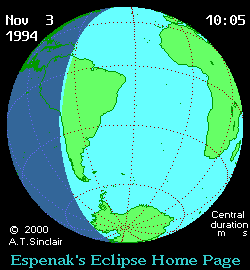| Total eclipse | |
 Totality with diamond ring effect in Litoral Province, Bolivia | |
| Gamma | −0.3522 |
|---|---|
| Magnitude | 1.0535 |
| Maximum eclipse | |
| Duration | 263 s (4 min 23 s) |
| Coordinates | 35°24′S34°12′W / 35.4°S 34.2°W |
| Max. width of band | 189 km (117 mi) |
| Times (UTC) | |
| Greatest eclipse | 13:40:06 |
| References | |
| Saros | 133 (44 of 72) |
| Catalog # (SE5000) | 9496 |
A total solar eclipse occurred at the Moon's ascending node of orbit on Thursday, November 3, 1994, [1] [2] [3] [4] [5] [6] [7] [8] [9] [10] [11] with a magnitude of 1.0535. A solar eclipse occurs when the Moon passes between Earth and the Sun, thereby totally or partly obscuring the image of the Sun for a viewer on Earth. A total solar eclipse occurs when the Moon's apparent diameter is larger than the Sun's, blocking all direct sunlight, turning day into darkness. Totality occurs in a narrow path across Earth's surface, with the partial solar eclipse visible over a surrounding region thousands of kilometres wide. Occurring about 10 hours after perigee (on November 3, 1994, at 23:40 UTC), the Moon's apparent diameter was larger. [12]
Contents
- Images
- Observations
- Eclipse timing
- Places experiencing total eclipse
- Places experiencing partial eclipse
- Eclipse details
- Eclipse season
- Related eclipses
- Eclipses in 1994
- Metonic
- Tzolkinex
- Half-Saros
- Tritos
- Solar Saros 133
- Inex
- Triad
- Solar eclipses of 1993–1996
- Saros 133
- Metonic series
- Tritos series
- Inex series
- References
- External links
Totality was visible in Peru, northern Chile, Bolivia, northern Argentina, Paraguay, Brazil and Gough Island of British overseas territory of Saint Helena, Ascension and Tristan da Cunha. The Iguazu Falls, one of the largest waterfalls systems in the world, lay in the path of totality. A partial eclipse was visible for parts of Central America, South America, Antarctica, and Southern Africa.








































































































